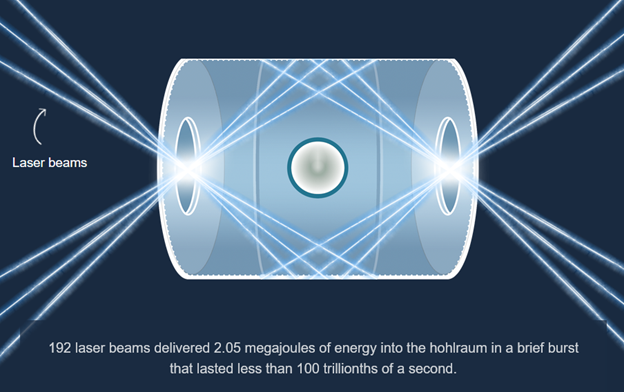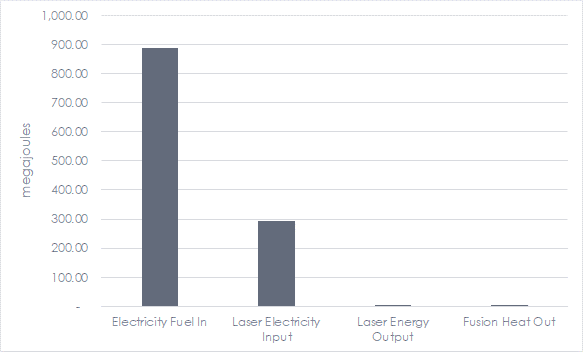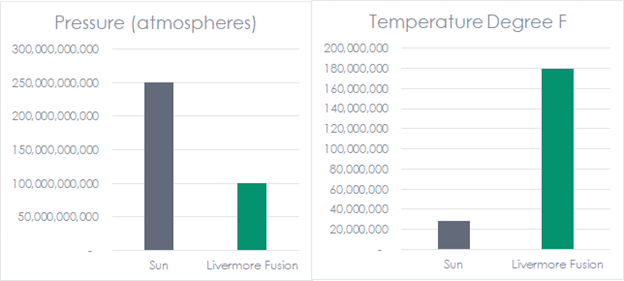
Just before last week’s finale on permanent peak demand reduction went to press, news dropped that nuclear fusion was successfully pulled off in the Livermore Laboratory in California. A controlled fusion reaction “produced more energy than it consumed,” according to The Wall Street Journal and many other outlets.
Before reading anything, my first reaction to the headline was 1) yawn and 2) they broke the second law of thermodynamics[1]. Later, I realized that they may have broken the first law of thermodynamics[2] as well.
Fusion Highlights
What is fusion? It is the slamming together of two hydrogen atoms to create helium and extreme heat, which is what happens in the sun, and that reminded me of the ditty from the They Might Be Giants from 1993.
The sun is a mass of incandescent gas, a gigantic nuclear furnace where hydrogen is built into helium at a temperature of millions of degrees.
We need its light. We need its heat. We need its energy.
Check it out. Click away!
 To a numbers nerd, the sun, a medium size star, is amazing. According to Physics.org, the sun’s heat is generated by only about 1.3% of its volume at the core, which operates at 250 billion atmospheres of pressure (3,673,987,193,968 psi) and 15.7 million degrees Kelvin (28,259,540°F). So yes, the Giants are correct.
To a numbers nerd, the sun, a medium size star, is amazing. According to Physics.org, the sun’s heat is generated by only about 1.3% of its volume at the core, which operates at 250 billion atmospheres of pressure (3,673,987,193,968 psi) and 15.7 million degrees Kelvin (28,259,540°F). So yes, the Giants are correct.
The Livermore experiment featured a mixture of hydrogen isotopes – deuterium and tritium. Hydrogen has one proton and one electron. Deuterium sticks a neutron into the nucleus with the proton, and tritium has two extra neutrons.
The Experiment
The cartoon below is courtesy of The Wall Street Journal. The laser energy produced X-rays that smushed the peppercorn wad of hydrogen isotopes to the diameter of a human hair, creating fusion and 3.15 megajoules from the 2.05 megajoules of laser energy. Whoopee!
 Burying the Hype
Burying the Hype
First, using ignorant science, this reaction is only 153% efficient. Using the same logic, a heat pump is 500% efficient with far less energy requirements.
The misleading facts of the case are laser energy, electrical energy, source fuel energy, and what the experiment produced: heat, the lowest form of energy.
Let’s start with the laser. Laser energy is produced with electricity, which is produced at an efficiency of about 33% for conventional steam cycles fueled by coal, natural gas, or nuclear fuel. Combined cycle natural gas plants are about 50-60% efficient. Wind and solar generation efficiency matters for converting heat or wind to electricity. Considering fuel cost, capacity cost, and intermittency, I will generously declare they are about the same concerning cost-effectiveness, so let’s assume 33% for reliable baseload electricity.
The Wall Street Journal reports that, per the director of the Livermore lab, lasers are about 0.7% efficient in converting electricity to laser energy. Uh oh.
Stacking the conversions of energy to deliver the fusion experiment’s output of 3.15 megajoules paints the picture. It takes at least 280 times the source fuel to produce the heat released by the fusion, good for 0.35% efficiency in the form of heat! This doesn’t include the energy required to produce the hydrogen, deuterium, tritium, or the energy needed to pressurize the reaction vessel.
Source energy losses through fusion heat output are demonstrated in the following chart.
A Scientific Accomplishment
For sure, the reaction is a remarkable scientific feat to mimic the sun, but an endless source of energy, this is not. Comparing the temperatures and pressures of the sun versus the Livermore fusion experiment, we have the following charted data. I reviewed my calculations multiple times because these numbers are so astronomical with no anchor for common sense (reality check).
Power Generation Obstacles
The point of the above chart is to show the astounding temperatures and pressures to make fusion go. On the way to generating electricity with fusion, the temperature may be less of a problem because a relatively large mass of working fluid, like water, can absorb a huge temperature from a tiny mass of fusion, like nuclear fission. The pressure seems like the problem of commercializing this, and then there is the pesky 0.35% energy conversion from source fuel to heat.
Washington Reacts
The day after the fusion reaction was announced, The Wall Street Journal reported that Fusion Industry Suddenly White-Hot After U.S. Lab Breakthrough. What do I think? I ask, how can I short-sell this reverie? Pay me 10% to save the other 90%?
Let’s examine what the lawmakers, policymakers, and mandate scribes have to say about Livermore’s parody of the sun and the decades to infinity of research and development required to generate electricity by copying the sun in a power plant.
From Politico:
“Just getting above one [in energy] net out is a milestone[3],” Paul Dabbar, a former DOE Undersecretary of Science.
Congressman Eric Swalwell: “Also, I hope it’s a recruiting boom as well. A lot of young physicists will see this as an opportunity to work on the energy source of the future.” This could be the most significant benefit of the experiment.
Senator Joe Manchin, also known as Senator Joe Mansion: “It can unlock and solve the energy challenges the whole world faces.”
Senator John Barrasso: “We’ve heard it’s always going to come, but it never does.” “This could be it. I’m very interested in following it, and I hope it’s real.”
Senator Jim Risch: “Fusion is the unicorn everybody chases. Someday, somebody will catch the unicorn.” That guy deserves the silver medal in cynicism. The gold is mine. Thanks.
Senator John Hoeven: “The idea they can produce more energy than is expended in creating the fusion is amazing.”
LOL.
[1] Examples of reversible reactions: 1) combustion products CO2 and H2O from hydrocarbon combustion converted back into wood, coal, oil, natural gas, or your fourth-grade report card with no energy input. Water runs uphill with no added energy (pumps). Heat moves from cold to warm with no energy input, thus eliminating the need for refrigeration.
[2] Conservation of energy. Any form of energy, including chemical, potential, kinetic, etc., when released, converts to useless heat after it has been harnessed and dissipated.
[3] Assuming the other conversions described in this post are ignored.

 Burying the Hype
Burying the Hype
